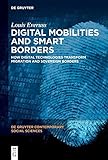Digital Mobilities and Smart Borders : How Digital Technologies Transform Migration and Sovereign Borders / Louis Everuss.
Material type: TextSeries: De Gruyter Contemporary Social Sciences ; 5Publisher: Berlin ; Boston : De Gruyter, [2024]Copyright date: 2024Description: 1 online resource (VII, 226 p.)Content type:
TextSeries: De Gruyter Contemporary Social Sciences ; 5Publisher: Berlin ; Boston : De Gruyter, [2024]Copyright date: 2024Description: 1 online resource (VII, 226 p.)Content type: - 9783110713978
- 9783110714166
- 9783110714050
- Digitale Unterstützung von Migration
- Digitalisierungspolitik
- Exklusion
- Globale Migration
- Internationaler Reiseverkehr
- Nationalstaaten
- Smart Borders
- Soziologie
- Staatsgrenzen
- Territorium
- SOCIAL SCIENCE / Emigration & Immigration
- Digital Enhancement of Migration
- Exclusion
- Global Migration
- International Travel
- Nation States
- Politics of Digitisation
- Smart Borders
- Sociology
- State Borders
- Territory
- online - DeGruyter
- Issued also in print.
| Item type | Current library | Call number | URL | Status | Notes | Barcode | |
|---|---|---|---|---|---|---|---|
 eBook
eBook
|
Biblioteca "Angelicum" Pont. Univ. S.Tommaso d'Aquino Nuvola online | online - DeGruyter (Browse shelf(Opens below)) | Online access | Not for loan (Accesso limitato) | Accesso per gli utenti autorizzati / Access for authorized users | (dgr)9783110714050 |
Frontmatter -- Acknowledgements -- Contents -- Introduction: Sovereignty and mobilities in a digitised world -- The spatial and temporal organisation of digitised borders -- Digital identities, algorithms and exclusion -- Modern bordering agency -- The digitisation of travel -- Travellers vs borders -- Conclusion: Reimagining border digitisation -- References -- Index
restricted access online access with authorization star
http://purl.org/coar/access_right/c_16ec
From smart gates and drone patrols to e-visas and mobile GPS apps, digital technologies are becoming a ubiquitous feature of state borders and travel. The embedding of digital technologies into bordering and travel processes is reshaping the ways people move around the world, as well as the means sovereign states use to control and facilitate that movement. Digital Mobilities studies these changes and examines how ‘digitisation’ is remaking the very fabric of state sovereignty, territory, and borders. Some of the core bordering and travel transitions prompted by digitisation that are examined in Digital Mobilities include the spatial and temporal reorganisation of borders; the algorithmic assessment of travellers as ‘data doubles’; the reformulation of border agency, or who or what performs the border; the digital augmentation of international travel; and the new tensions and conflicts arising between smart borders and digital mobilities. Understanding these transitions is essential for policy makers, advocates, and members of the public to comprehend both the exceptional opportunities and monumental risks posed by the embedding of digital technologies into borders and travel.
Issued also in print.
Mode of access: Internet via World Wide Web.
In English.
Description based on online resource; title from PDF title page (publisher's Web site, viewed 20. Nov 2024)


